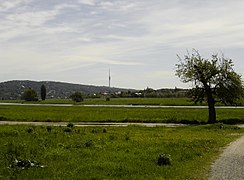Elbe meadows (Dresden)

The Elbe meadows in Dresden form the banks of the Elbe and, with the exception of the Brühlsche Terrasse and the terrace bank in front of it, as well as the New Terrace at the Landtag , stretch across the city. The total length of the Elbe meadows is around 30 kilometers on both sides of the river. Its width varies between a few meters below the Elbe castles , where the Elbe comes close to the Elbe slope , and up to 400 meters on the opposite bank.
Cityscape
The Elbe meadows cut through the entire city and thus ensure a soft cityscape . In the southeast, the northern Elbe meadows merge directly into the wooded slope of the Elbe and the Dresden Heath , which is why the Elbe meadows form the boundaries of the urban space in the immediate vicinity of the city center . Along the Dresden Elbhang there are some old village centers, such as Wachwitz , Niederpoyritz or Pillnitz , which are in contrast to the much more urban districts such as Blasewitz or Laubegast on the opposite side of the Elbe.
The Elbe meadows reinforce the shape of the Elbe meanders, especially in the southeast between the village districts. On the rebound slope below the Elbe slope they are narrow and steep while on the opposite sliding slope they are very flat and extremely wide.
The scenic character of the Elbe meadows is also retained in the neighboring communities and cities (such as Pirna or Radebeul ). The Elbe meadows are not only of scenic value for Dresden, but also for the entire metropolitan area . Its enormous influence on the entire cityscape was recognized in 2004 when it was named a World Heritage Site in Dresden Elbe Valley . As a result of the construction of the Waldschlößchenbrücke , the World Heritage title was revoked again in 2009.
Recreation and leisure

The Elbe meadows can be reached quickly from many parts of the city. They are used intensively for local recreation, especially for walking, doing sports and celebrating. From 1952 until the so-called “military coup” in the aviation sections of the Society for Sport and Technology in 1979, the Elbe meadows on the left were used as a glider airfield.
Annual major events such as the film nights on the banks of the Elbe take place on the Elbe meadows . During the Dresden bridge dispute , citizens' initiatives feared that the local recreational value would be significantly impaired locally by the Waldschlößchenbrücke , as it crosses the Elbe meadows at its widest point.
The Elbe meadows are in the immediate vicinity of densely populated districts such as Blasewitz, Striesen , Pieschen , Cotta and most of Dresden's suburbs . About 155,000 residents of Dresden live in the districts through which the Elbe meadows pass.
Agriculture

The Elbe meadows are partially demarcated pastures. Sheep flocks are sometimes used to maintain the meadows, which are by no means to be understood as lawns. It is a common image that sheep graze directly in front of the silhouette of the old town. Large parts of the Elbe meadows are landscape protection areas and their possible uses are therefore defined.
Most of the areas are not used by pastures, but are accessible agricultural land that is used as fodder meadow . Hay is usually harvested twice a year . The mowing of the meadows is important for the preservation of the cultural landscape, as the meadows else with tall perennials or shrubs would overgrown.
Water management
Parts of the Elbe meadows are used to produce drinking water, for example through the Hosterwitz waterworks on the northern side of the Elbe and the Tolkewitz waterworks on the southern side of the Elbe. The Saloppe waterworks is located on the Elbe meadows, but catches water from the Dresden Heath at the exit of the Mordgrundbach valley .
Environmental and landscape protection

The Elbe meadows are not a natural landscape , but a cultural landscape that has been modified and cultivated by man . Almost all areas of the Elbe meadows in Dresden are protected by areas of nature conservation , especially landscape protection. These areas are:
- The Fauna-Flora-Habitat 34E Elbe Valley between Schöna and Mühlberg
- The landscape protection area d65 Dresden Elbe meadows and arms
- The landscape protection area d32 Elbe slopes Dresden-Pirna and Schönfelder Hochland
In addition, many individual landscape components are protected in the form of natural monuments , nature reserves or individual biotopes.
Flood protection
In Dresden there are only a few dikes (such as at Gohlis ). Rather, flood protection should be achieved via the flood area of the Elbe meadows and the old Elbarme. These are usually silted up. Normal floods, which are between 4 and 7 meters high in Dresden, therefore have little impact on the city's infrastructure and buildings. Built-up areas are flooded from water levels of around 8 meters, for example during the Elbe flood in August 2002 . The principle of leaving the river relatively uneven and unrestricted ensures good natural protection during floods. The Dresden Elbe valley widening is of course a retention area for the river.
A few kilometers upstream, almost the entire area of the Czech Republic is drained through the breakthrough valley in the Elbe Sandstone Mountains . When passing this mountain valley, the Elbe increases its flow speed before it merges into the flat middle course in the greater Dresden area.
View from below the Waldschlösschen over the Elbe to the Käthe-Kollwitz-Ufer
Individual evidence
- ↑ Glider airfield at johannstadtarchiv.de, accessed on March 14, 2014
- ^ Ordinance of the state capital Dresden establishing the landscape protection area “Dresden Elbe meadows and altars”. (PDF; 43 KB) Retrieved July 30, 2017 .



